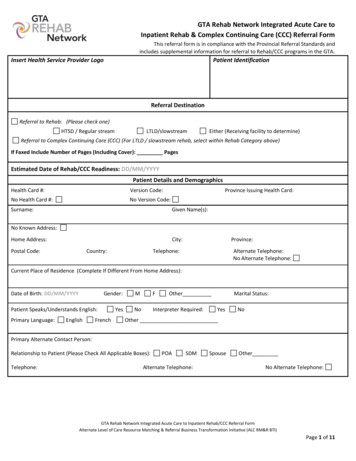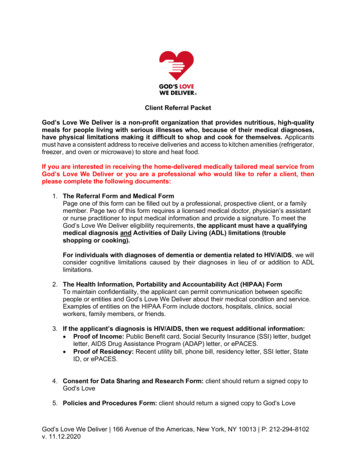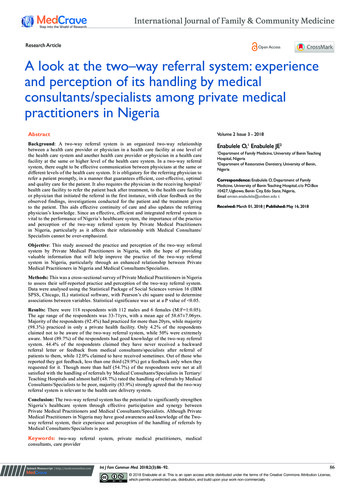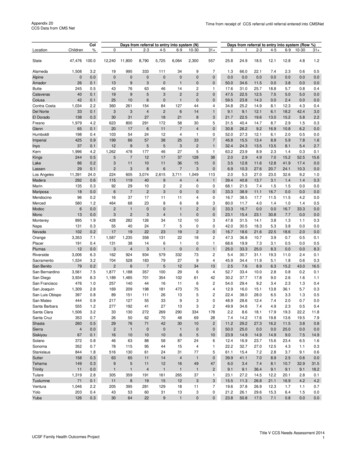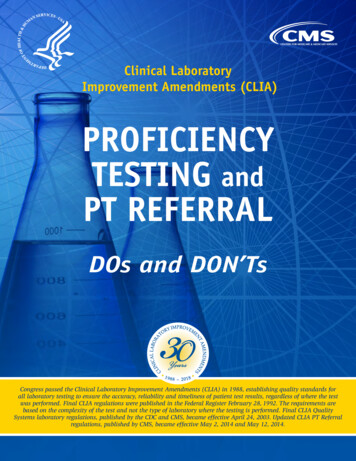
Transcription
Clinical LaboratoryImprovement Amendments (CLIA)PROFICIENCYTESTING andPT REFERRALDOs and DON’TsCongress passed the Clinical Laboratory Improvement Amendments (CLIA) in 1988, establishing quality standards forall laboratory testing to ensure the accuracy, reliability and timeliness of patient test results, regardless of where the testwas performed. Final CLIA regulations were published in the Federal Register February 28, 1992. The requirements arebased on the complexity of the test and not the type of laboratory where the testing is performed. Final CLIA QualitySystems laboratory regulations, published by the CDC and CMS, became effective April 24, 2003. Updated CLIA PT Referralregulations, published by CMS, became effective May 2, 2014 and May 12, 2014.
IMPORTANT INFORMATION FORLABORATORIES PERFORMINGNON-WAIVED TESTSFrequently Asked Questions about CLIA Requirementsfor Proficiency Testing (PT) and PT ReferralThe following information applies only to CMS inspected laboratories. If your laboratory is accredited, you MUSTfollow the proficiency testing requirements of your accreditation organization. This does not apply to cytology PT.What is proficiency testing?Proficiency testing, or PT, is the testing of unknown samples sent to a laboratory by anHHS-approved PT program. Most sets of PT samples are sent to participating laboratorieson a scheduled basis (usually three times per year). After testing, the laboratory reports itssample results back to their PT program. The program grades the results using the CLIAgrading criteria and sends the laboratory their scores. CMS and accreditation organizationsroutinely monitor their laboratories’ performance.Why is PT important?PT is important because it is a tool the laboratory can use to verify the accuracy andreliability of its testing, and can also be used to validate the entire testing process,including competency of your testing personnel. Routine reviews of PT reports by thelaboratory staff and the laboratory director will alert them to areas of testing that are notperforming as expected as well as indicate subtle shifts and trends that, over time, wouldaffect their patient results.If I only perform waived testing, am I required to perform PT?PT is not required for any test classified as waived. However, enrolling in a PT programand performing PT on your waived test(s) will provide you with an excellent indicationof the accuracy and reliability of your waived test results thus improving the quality oftesting you provide for your patients. It also serves to demonstrate the accuracy of yourtesting if it is ever questioned. You may check the FDA web site to determine whetheryour test(s) are waived: /cfCLIA/search.cfm.Please note: If your laboratory enrolls in PT for waived testing, all regulations related toPT referral apply.Is PT required for all non-waived testing?PT is required for only the limited number of tests found in Subpart I, ProficiencyTesting Programs for Non-Waived Testing, of the CLIA regulations. If your laboratory2
performs any of the tests found in Subpart I, you must enroll in a CMS-approved PTprogram and perform PT on each of the tests. We refer to the tests listed in Subpart I as“regulated” analytes.A listing of these tests may be found on pages 10-11 of this brochure or can be found onthe CLIA website link at the end of this brochure.Can I enroll in any program that offers PT?You must enroll in a CMS-approved PT program. A detailed listing of these programsalong with their contact information and the tests for which they are approved is availableat: lation/CLIA/index.html. Clickon “Proficiency Testing Programs”.What must I do to enroll in PT?Using the list on the CLIA web site, choose one (more than one, if your director wishes)of the approved PT program(s) that offer(s) the tests you perform in your laboratory.The PT program will assist you with your enrollment. Call your PT program; the PTrepresentatives will help you enroll properly. Assisting you with proper enrollment isa CLIA requirement for approved PT programs. If more than one PT program is chosenfor any given test, the lab must designate which PT program will be used to meet CLIArequirements. The program will notify CMS of your enrollment and the PT testing youhave signed up to perform.If I have more than one testing site, do I need to enroll in PT for each site?PT enrollment and participation is required for each CLIA certificate, i.e., PT percertificate (excluding certificate of waiver). If you offer non-waived testing at morethan one site, but the testing is all included under one certificate, you must enroll in anapproved PT program(s) for all the “regulated” analytes covered under that certificate,not for each site. However, PT testing should be rotated through all of the sites under thesingle CLIA certificate. For example, one event is performed by Site “A”, then the nextevent would be tested at Site “B”, and so on until all sites have participated. Continueto rotate events between sites. PT events should never be shared between sites (e.g.,each PT event should not be given to all of the sites to betested and produce results which are then compared oraveraged for submission to the PT program). If you have aseparate certificate for each site, you must enroll in PTfor the tests performed at each site. It also may be helpfulto enroll each site in a different PT provider to avoid anyappearance of PT referral.May I change my PT program whenever I wish aslong as it is CMS-approved?You may not randomly change from one approved PTprogram(s) to another during the first year of participatingwith a program. Laboratories must enroll and participatein one approved program or programs for one year beforedesignating a different program. You must also notify CMSbefore any change in PT program.3
If my laboratory is new or if I add a new “regulated” specialty, subspecialty oranalyte in the middle of a calendar year, how quickly must I enroll in PT?Laboratories operating under a new certificate and/or adding new “regulated” testingmust enroll in PT as soon as possible and complete the PT for the remainder of the year.If I perform “unregulated” testing (tests for which PT is not required), am Irequired to check the accuracy and reliability of those tests?CLIA requires laboratories to take steps to assure the accuracy of testing in lieu of testingPT samples. CLIA requires that, at least twice annually, you verify the accuracy of anytest or procedure that you perform that is not listed in Subpart I.How do I verify the accuracy of the tests that do not have PT required?A few examples of ways to check the accuracy of testing not listed in Subpart I areas follows: Split a patient’s specimen (never split a PT sample) with another laboratory thatoffers the same test(s). Your director should review your results and the otherlaboratory’s results for acceptability. Enroll in PT with a CMS-approved program (Note: If you enroll and participate inPT with a CMS-approved PT program, all regulations related to PT referral applyregardless if the analyte is listed in Subpart I or certificate type).Are there ever circumstances in PT that require my laboratory to verify theaccuracy of “regulated” tests?Yes there are. There are times when the PT program cannot fully evaluate your samplesand you must verify accuracy of those results. You must verify the accuracy of tests forwhich PT is required if any of the following occur: When your results are submitted to the program after the deadline and are considereda late submission, your laboratory grade will be zero. If you did not test your PT samples at all, your laboratory grade will be zero. There are instances when your grade does not reflect your performance because therewas no consensus among all laboratories performing the PT sample(s). You will seethis identified by the PT program on your results report as “Not Graded” or with acode to indicate the reason the sample was not graded. You will be assigned an artificialscore of “100%”, but that does not reflect your actual performance or the accuracyof your laboratory’s testing.If I perform the same test using two different test systems, must I perform PTon both test systems?PT is required for only the test system, assay, or examination used as the primary methodfor patient testing during the PT event.4
How long do I have to test and report the PT samples?The instructions that accompany the PT samples will state theexact date by which you must return your PT results to theprogram. It is very important to return them on time. A latesubmission will result in a score of zero (0 %) for the testing event.What steps should I take after I have received my PTresults from the PT program?Always review your results with your co-workers and your director.Your PT program will include an evaluation for each of the fivechallenges for each test or analyte in the PT event and will detailthe performance of each test system used by the laboratories enrolled with their program.You must evaluate your PT results against the scores published by the PT program.This should be done for all PT results, even those with passing scores. If you receivean 80% score, you should investigate why one of the five samples was outside theacceptable range of results. Document your investigation and what you did to correctthe problem that caused the challenge failure. If you discover the issues which led to the80% score, it could lead to more serious failures in the future.What must I do if I do not get a passing score when the PT program gradesmy results?Re-review the results that were submitted to the PT program for scoring for any obviouserrors (this should have been done prior to submitting your results to the program).Clerical or transcription errors are considered incorrect results. The director of yourlaboratory, as well as the personnel who performed the testing of the PT samples, shouldcompare their PT results with the inter-laboratory comparison evaluations providedby the PT program. You must take remedial actions, i.e., determine the cause of theerror or errors, correct it (them), and document your actions. You must also look backat your patient results reported during the period when your PT was unsatisfactory orunacceptable. If the review identifies that patients were affected, or potentially affected,during this period of time, you must address the patient results. Continually monitor thetest system performance, review the results of the quality control materials, and discusswith your director to be certain the test system is operating properly and producingaccurate results. Depending upon the test system’s performance and your director’sdecision, you may need to contact the manufacturer of the test system for assistance.What does unsatisfactory PT performance mean?Unsatisfactory PT performance means failure to attain the minimum satisfactory scorefor an analyte, test, subspecialty, or specialty for a testing event. This may also bereferred to as “unacceptable” performance.What does unsuccessful participation in PT mean?Unsuccessful participation in PT means any of the following: Unsatisfactory performance for the same analyte in two consecutive or two out ofthree testing events.5
Repeated unsatisfactory overall testing event scores for two consecutive or two outof three testing events for the same specialty or subspecialty. An unsatisfactory testing event score for those subspecialties not graded byanalyte (that is, bacteriology, mycobacteriology, virology, parasitology, mycology,compatibility testing, unexpected antibody detection, antibody identification) forthe same subspecialty for two consecutive or two out of three testing events.What does unsuccessful PT performance mean?Unsuccessful PT performance means a failure to attain a satisfactory score for an analyte,subspecialty, or specialty for two consecutive or two of three consecutive testing events.*Please note: Unsuccessful performance and unsuccessful participation are interchangeable.CMS inspectors generally will use unsuccessful performance.If I do not successfully participate in PT, what happens?If your laboratory has not had a prior unsuccessful performance for any PT analyte,subspecialty, or specialty, the CLIA regulations, under certain circumstances, maypermit technical assistance and training to take place, rather than a more serioussanction. However, repeated unsuccessful PT performance for that same analyte,subspecialty, or specialty may result in your laboratory no longer being allowed toperform the failed testing.You may decide to voluntarily stop testing the unsuccessful analyte, subspecialty, orspecialty. As soon as you receive your PT results indicating an unsuccessful performance,you must notify your State Agency and Regional Office CLIA consultant* that testing of theunsuccessful analyte, subspecialty, or specialty has been stopped voluntarily.*Note: The notification that you have ceased testing must be made before you receivea letter from your CMS Regional Office imposing a cease testing sanction. If youvoluntarily cease testing and then successfully perform two consecutive PT events for theanalyte, subspecialty, or specialty that was unsuccessful, your Medicare and Medicaidreimbursement may not be affected.My laboratory has been required to cease testing an unsuccessful analyte,subspecialty, or specialty. What must I do to be able to resume testing?First, you must demonstrate that your laboratory has identified the reason(s) for yourunsuccessful performance and has corrected it (them). Be sure to document this process.Secondly, when you are certain you have corrected the problem(s), your laboratorymust perform two consecutive PT events (re-instatement PT) successfully, which willdemonstrate correction of the problem(s).If sanctions have been imposed and you have been required to cease testing, yourMedicare and Medicaid reimbursement and your CLIA certificate will be suspendedor limited for a six month period. However, you may purchase your re-instatement PTevents at any time after you have identified and corrected the problem(s) that caused theunsuccessful performance. You should purchase these samples from your PT program, butyou may obtain them from any CMS-approved PT program.6
Do I need to keep records of my PT testing?Yes, you must keep a copy of all your records, such as the step by step PT samplepreparation and handling, all the steps taken in the testing of the sample, instrumentprintouts, a copy of the PT program results form used to record and submit yourPT results (includes the attestation statement), a print screen if results are enteredelectronically, and the PT program’s evaluation of your laboratory’s performance, etc.These copies must be maintained for a minimum of two years from the date of the PTevent. If any corrective actions are taken as a result of an unsatisfactory or unacceptablescore, records of these actions must also be maintained for two years.Do I test my PT samples any differently than I test patient specimens?PT samples must be tested in the same manner you test patient specimens. This meanstesting the PT samples the same number of times as you would patient specimens,at the same time as patient specimens, by the same personnel that routinely test thepatient specimens, and using the same test system, including analyzer and reagents, thatis routinely used for the patient specimens. PT samples should be rotated among thetesting personnel in your laboratory.Please note that some PT sample preparation may be necessary before testing. It isimportant for your staff to read the specimen handling and preparation sections of the PTbooklet that comes with each event to determine if PT samples require special treatmentprior to testing. In other words, after preparation, PT samples must be treated in the samemanner as patient specimens. However, as stated below, never send PT samples out ofyour laboratory for any reason, even if you routinely send out patient specimens foradditional testing. Your laboratory should only test the PT sample as it would a patientspecimen up until the point it would refer a patient specimen to a second laboratory forany form of further testing (i.e., distributive, confirmatory, reflex testing).What is PT Referral?Quite simply, PT referral is when one laboratory (Laboratory A) sends its PT samples toanother laboratory (Laboratory B) or multiple laboratories (Laboratories B, C, D, etc.)for any reason. Whether or not acts are authorized or even known by the laboratory’smanagement, a laboratory is responsible for the acts of its employees. Generally,PT referral is considered to be intentional. Over the course of the CLIA program,“Intentional” has been legally interpreted to mean the“intent to act” regardless of motivation. However, in casesof PT referral where one laboratory refers their PT samplesto another laboratory for testing, but that testing is limitedto distributive, confirmatory, or reflex testing, and if thereferring laboratory had an approved procedure in placeat the time of the referral and the laboratory had not beensanctioned for PT referral previously, the referral will beconsidered improper rather than intentional.Your laboratory will need to have procedures in placeand train employees on those procedures to prevent stafffrom forwarding PT samples to other laboratories even in7
instances in which they would normally forward a patient specimen for testing.Please note: PT referral applies to any PT samples referred to another laboratory fortesting regardless if they are analytes found in Subpart I (“regulated analytes”), not foundin Subpart I (“unregulated analytes”), or waived tests.What happens if my laboratory refers PT samples to another laboratoryfor testing?The PT referral regulations, effective May 2014, provide a specific framework forapplication of sanctions for PT referral cases and are based on the severity and extent ofthe violation. These regulations include three categories of sanctions for a PT referral tobe applied under certain specified conditions: Category 1 is for the most egregious violations, encompassing cases of repeat PTreferral, regardless of circumstances revolving around the violation, and cases wherea laboratory reports another laboratory’s PT results as its own to the PT program onor before the PT event close date. Category 2 is when a laboratory refers its PT samples to another laboratory foranalysis and obtains test results for the PT samples from the other laboratory on orbefore the cut-off date for the PT event, but reports its own PT sample results to thePT program. Category 3 includes cases of PT referral where the laboratory refers its PT samples toanother laboratory for analysis and obtains test results for the PT samples from theother laboratory after the cut-off date for the PT event. This category also includesthe carve-out for confirmatory, distributive, and reflex testing.Each case of potential PT referral will be evaluated to determine if PT referral occurred,and if so, which of the three categories is applicable to the specifics facts.Please note: Repeat proficiency testing referral means a second instance in which aproficiency testing sample, or a portion of a sample, is referred, for any reason, to anotherlaboratory for analysis prior to the laboratory’s proficiency testing program event cut-offdate within the period of time encompassing the two prior survey cycles (including initialcertification, recertification, or the equivalent for laboratories surveyed by an approved AO).This means that if a laboratory has been sanctioned for any category of PT referral in theprior two survey cycles, the second, or “repeat” referral will be considered a Category 1.May I discuss my PT results with another laboratory?Never discuss your PT results with another laboratory and never enter into discussionwith another laboratory about their PT results before the PT event cut-off date. Thisactivity may result in sanction(s) taken against your CLIA certificate.May I send my PT samples to another laboratory to see if they get the sameresults as I do?Never send your PT samples to another laboratory even if you send your patientspecimens to another laboratory. (Please read the PT results sheet carefully and select“Would refer” or “Test not performed” in these instances.) Sending PT samples to8
another laboratory for testing is considered PT referral and willcause serious action(s) to be taken against your laboratory,and may cause adverse actions against your laboratory directorand the laboratory owner. The penalties may include loss,suspension, or limitation of your laboratory’s CLIA certificate;your director’s being unable to direct a laboratory for two years;your laboratory operator/laboratory director/owner losingthe rights to own or operate a laboratory for two years; and adirected Plan of Corrections and/or civil money penalty (CMP).Your laboratory’s name will be listed on the CMS LaboratoryRegistry on the CMS web site.Be extremely cautious not to send PT samples out for a confirmatory, distributive, andreflex testing: Confirmatory testing means testing performed by a second analytical procedurethat could be used to substantiate or bring into question the result of an initiallaboratory test.Example: Pos HIV screen or Pos Lyme Western Blot Distributive testing means laboratory testing performed on the same specimen, or analiquot of it, that requires sharing it between two or more laboratories to obtain alldata required to complete an interpretation or calculation necessary to provide a finalreportable result for the originally ordered test. When such testing occurs at multiplelocations with different CLIA certificates, it is considered distributive testing.Example: Protein Electrophoresis – Lab A does electrophoresis, Lab B doesTotal Protein Reflex testing means confirmatory or additional laboratory testing that isautomatically requested by a laboratory under its standard operating proceduresfor patient specimens when the laboratory’s findings indicate test results that areabnormal, are outside a predetermined range, or meet other pre-established criteriafor additional testing.Example: Pos Hep A screen Total vs IgM, Pos E.coli serotypingWhat do I do if I receive PT samples from another laboratory for testing?As soon as you identify them as PT samples, notify your inspecting agency (youraccreditation organization if your laboratory is accredited or your State Agencyinspectors) that you have received PT samples from another laboratory. Tell them the nameof the other laboratory and the test(s) requested, but do not test the samples.Be sure to read the CLIA regulations for proficiency testing and PT referral (availableon the CMS web site). This brochure is not intended to replace or be a substitutefor the CLIA regulatory requirements. It is intended only to present most of theproficiency testing requirements in layman’s terms.9
LIST OF NON-WAIVED TESTING FOR WHICHPT IS REQUIREDMICROBIOLOGYAntistreptolysin OBacteriologyAnti-Human Immunodeficiency Virus(Anti-HIV)Aerobic/Anaerobic Culture &IdentificationComplement C3Antibiotic Susceptibility TestingComplement C4Direct Bacterial Antigen DetectionHepatitis B Surface Antigen (HBsAg)Gram StainHepatitis B Core Antibody (Anti-HBc)Hepatitis Be Antigen (HBeAg)MycobacteriologyImmunoglobulins, total:IgA, IgG, IgM, IgEAcid Fast StainMycobacteriology IdentificationInfectious MononucleosisMycobacteriology Susceptibility TestingRheumatoid FactorMycologyRubellaCulture and IdentificationCHEMISTRYParasitologyRoutine ChemistryPresence or Absence of ParasitesAlanine Aminotransferase (ALT/SGPT)Identification of ParasitesAlbuminVirologyAlkaline PhosphataseDirect Viral Antigen DetectionAmylaseViral Isolation and IdentificationAspartate Aminotransferase(AST/SGOT)DIAGNOSTIC IMMUNOLOGYBilirubin, totalSyphilis SerologyGeneral ImmunologyBlood Gases:pH, pCO2, pO2Alpha-1 AntitrypsinCalcium, totalAlpha Fetoprotein (tumor marker)ChlorideAntinuclear AntibodyCholesterol, total10
Cholesterol, HDLLithiumCreatine Kinase, totalPhenobarbitalCreatine Kinase, Isoenzyme mide andMetaboliteIron, totalQuinidineLactate Dehydrogenase (LDH), totalTheophyllineLDH Isoenzymes (LDH1/LDH2)TobramycinMagnesiumValproic acidPotassiumSodiumHEMATOLOGYTotal ProteinCell IdentificationTriglyceridesWBC DifferentialUrea NitrogenErythrocyte CountUric cyte CountFree ThyroxinePlatelet CountHuman Chorionic GonadotropinFibrinogenT3 UptakePartial Thromboplastin TimeTriiodothyronineProthrombin TimeThyroid Stimulating HormoneThyroxine, totalIMMUNOHEMATOLOGYToxicologyABO GroupBlood AlcoholD (Rho) TypingBlood LeadUnexpected Antibody DetectionCarbamazepineCompatibility TestingDigoxinAntibody IdentificationEthosuximideGentamicin11
For additional information and guidanceAssistance for meeting the requirements is provided inAppendix C of the State Operations Manual, which is postedon CMS’ CLIA website, shown below, under “InterpretiveGuidelines for Laboratories”. You can find a list of RegionalOffice and State Agency contacts there as Legislation/CLIA/index.htmlSeptember 2017
Clinical Laboratory Improvement Amendments (CLIA) PROFICIENCY TESTING. and. PT REFERRAL. DOs and DON'Ts. Congress passed the Clinical Laboratory Improvement Amendments (CLIA) in 1988, establishing quality standards for
